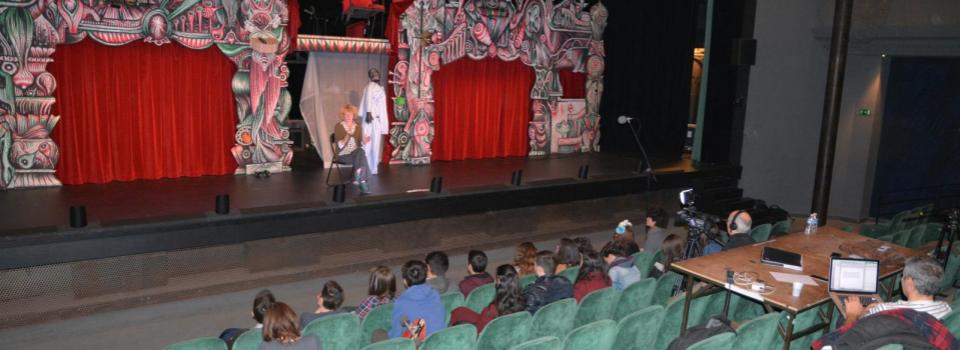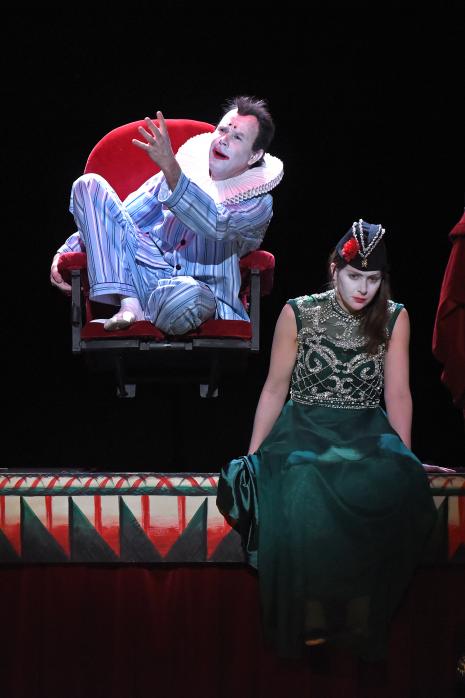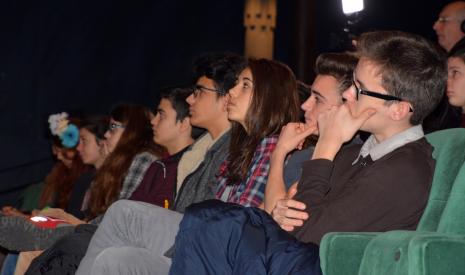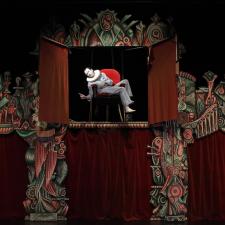
Richard III – Loyaulté me lie # 24
Pupils from the lower sixth form theatre class have followed the making process of the play “Richard III –Loyaulté me lie”. As part of a project led by their teacher Laëtitia Le Van, they were welcomed by and involved in the Théâtre de l’Union’s team, in particular Jean Lambert-wild, Christofhe Mourlon Caffin and assistant dramaturge Zelda Bourquin.
Their experience was twofold: they were the recipients but also the transmitters of that experience. As observers, they followed several creative processes:they attended a reading of the Diaries written about the project, observed a rehearsal, had dedicated meetings and conversations with Jean Lambert-wild, Claire Seguin, Gérald Garutti, Lorenzo Malaguerra, Jean-Pierre Han – critic and theatre criticism historian… As “actors”, they were, among other things, ambassadors of the project to their peers from the Theatre sections of their college; they also directed and performed scenes from Shakespeare’s text in the streets of Limoges – a breath-taking “Richard III express”; they interviewed Jean Lambert-wild and Claire Seguin for Réseau Canopé and Théâtre de l’Union.
In their first meeting with Théâtre de l’Union’s director, they were given a new mission and put in charge of three of the Diaries. Their experience provided the through-line of their writing in which they modestly give an account of their experience over four months.
Open rehearsal (2/3)
On Wednesday 16 December, we attended an open rehearsal at Théâtre de l’Union. When we arrived, we discreetly took place on the theatre’s notorious green seats. We were surprised by the magnificent set that was occupying the whole stage: a very impressive, imposing, unexpected façade. It looked like the setting of an old funfair, a ghost ride, an artist castle, a street in a western … Some of us even saw totem-like shapes in it. We then imagined how the two actors were going to evolve in that space throughout the show. This is when we turned to look at the two performers on stage: Jean Lambert-wild and Élodie Bordas, who were doing a read through.
Then, they worked on the scene where Elizabeth discovers her two sons have been murdered by Richard III, their uncle. This scene follows the one where Richard III shoots his mother who is hiding on the other side of the curtain. The actors and the directors had to think about the place where the rifle should be placed before Richard picks it up, and where he should put it afterwards. They decided to hide the rifle in the set. Richard shoots it three times, look at the audience, smiles, rushes to take out a fabric camping chair and sits on it, downstage. Stage right, the curtain opens on a shooting gallery where we see Elizabeth, Richard’s sister-in-law. She holds in her hands two eaten and crushed candyflosses. They represent the corpses of her sons, whom Richard has had assassinated. She laments her fate and it is at that very specific moment that Richard chooses to tell her he wishes to marry her daughter.
This is when we witness an obstacle in the direction. The two directors, Lorenzo Malaguerra and Gérald Garutti, didn’t agree with the way Jean Lambert-wild suggested he should play this scene. Lorenzo wanted Jean’s character to be more sensitive, closer and more manipulative, since the woman he was talking to was distraught because she had lost her children. Lambert-wild doesn’t agree with this perspective because it would create yet another scene of seduction, like the one with Lady Anne. He wants to say these words coldly, mechanically, with no emotion, because he reckons that since Richard III is king he shouldn’t have to make any effort. He is the one who has the power, and Elizabeth has to obey. The atmosphere in the rehearsal room becomes tense, they can’t find an agreement. Should this be played with sincerity or formality? Should they calm things down, so there is a moment of calm in the show? Should we feel Richard III’s domination? Witnessing this disagreement makes us feel uneasy. It made us feel like we were witnessing something intimate. Some of us would have liked to give an opinion. Others noted that professionals were encountering the same difficulties as amateurs were. Lambert-wild couldn’t find the performance mode that fitted with his clown. He couldn’t find an anchorage in his words. Dead end. Fiercely looking for a solution.
The two actors agreed among themselves and suggested another version: they stood away from their seats, so they are less static. Everyone liked this new way of playing the scene, with more movement, and the atmosphere relaxed. They even started laughing!
We had to wait a month before we could see this rehearsal’s final result in performance.
The scene in the show had completely changed. We saw it from a different perspective. Visually as well as from the perspective of the scene. No more blocking downstage. Elizabeth appears on the red throne that hangs over the set, symbolising the power of the king. Her legs are bare, open. Instead of holding the candyflosses like baby dolls, she drops them in the void, hopeless. Her bare and open legs can be interpreted in various ways: she either wants to be provocative and rather flirtatious, or they represent the fact that she has been assaulted, maybe even raped: she seems weak, exhausted, abandoned, with no restraint. This made us think of the act of giving birth, or perhaps a masculine posture to dominate, in front of Richard III. He doesn’t need to be emotional or seductive to convince her: he is the king, so he takes for granted that she must obey him. Some of us liked this idea of a power play, others thought that the space didn’t allow the violence and aggressiveness of the text to be expressed.
This experience allowed us to measure how important both direction and collective research are.

Richard III’s piglets,
Pupils from the lower sixth form theatre class (Première option Théâtre), Lycée Limosin
- Richard III – Loyaulté me lie # 01
- Richard III – Loyaulté me lie # 02
- Richard III – Loyaulté me lie # 03
- Richard III – Loyaulté me lie # 13
- Carnet de bord # 16 Richard III – Loyaulté me lie
- Carnet de bord # 17 Richard III – Loyaulté me lie
- Carnet de bord # 18 Richard III – Loyaulté me lie
- Carnet de bord # 19 Richard III – Loyaulté me lie
- Carnet de bord # 20 Richard III – Loyaulté me lie
- Carnet de bord # 21 Richard III – Loyaulté me lie
- Carnet de bord # 22 Richard III – Loyaulté me lie
- Carnet de bord # 23 Richard III – Loyaulté me lie
- Richard III – Loyaulté me lie # 04
- Richard III – Loyaulté me lie # 05
- Richard III – Loyaulté me lie # 06
- Richard III – Loyaulté me lie # 07
- Richard III – Loyaulté me lie # 08
- Richard III – Loyaulté me lie # 09
- Richard III – Loyaulté me lie # 10
- Richard III – Loyaulté me lie # 11
- Richard III – Loyaulté me lie # 12
- Richard III – Loyaulté me lie # 14
- Richard III – Loyaulté me lie # 15
- Richard III – Loyaulté me lie # 16
- Richard III – Loyaulté me lie # 17
- Richard III – Loyaulté me lie # 18
- Richard III – Loyaulté me lie # 19
- Richard III – Loyaulté me lie # 20
- Richard III – Loyaulté me lie # 21
- Richard III – Loyaulté me lie # 22
- Richard III – Loyaulté me lie # 23
- Richard III – Loyaulté me lie # 24





